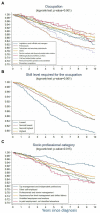Breast cancer and occupation: Non-parametric and parametric net survival analyses among Swiss women (1990-2014)
- PMID: 37089493
- PMCID: PMC10115164
- DOI: 10.3389/fpubh.2023.1129708
Breast cancer and occupation: Non-parametric and parametric net survival analyses among Swiss women (1990-2014)
Abstract
Introduction: Occupation can contribute to differences in risk and stage at diagnosis of breast cancer. This study aimed at determining whether occupation, along with skill level and the socio-professional category, affect the breast cancer survival (BCS) up to 10 years after diagnosis.
Materials and methods: We used cancer registry records to identify women diagnosed with primary invasive breast cancer in western Switzerland over the period 1990-2014 and matched them with the Swiss National Cohort. The effect of work-related variables on BCS was assessed using non-parametric and parametric net survival methods.
Results: Study sample included 8,678 women. In the non-parametric analysis, we observed a statistically significant effect of all work-related variables on BCS. Women in elementary occupations, with low skill level, and in paid employment not classified elsewhere, had the lowest BCS, while professionals, those with the highest skill level and belonging to top management and independent profession category had the highest BCS. The parametric analysis confirmed this pattern. Considering elementary occupations as reference, all occupations but Craft and related trades had a hazard ratio (HR) below 1. Among professionals, technicians and associate professionals, and clerks, the protective effect of occupation was statistically significant and remained unchanged after adjustment for age, calendar period, registry, nationality, and histological type. After adjusting for tumor stage, the HRs increased only slightly, though turned non-significant. The same effect was observed in top management and independent professions and supervisors, low level management and skilled laborers, compared to unskilled employees.
Conclusion: These results suggest that work-related factors may affect BCS. Yet, this study was conducted using a limited set of covariates and a relatively small study sample. Therefore, further larger studies are needed for more detailed analyses of at risk occupations and working conditions and assessing the potential interaction between work-related variables and tumor stage.
Keywords: breast cancer; cancer registry; cohort; female worker; occupational epidemiology; occupational exposure; return to work.
Copyright © 2023 Guseva Canu, Bovio, Arveux, Bulliard, Fournier, Germann, Konzelmann, Maspoli, Rapiti and Grzebyk.
Conflict of interest statement
The authors declare that the research was conducted in the absence of any commercial or financial relationships that could be construed as a potential conflict of interest.
Figures


Similar articles
-
Work-Related Factors and Lung Cancer Survival: A Population-Based Study in Switzerland (1990-2014).Int J Environ Res Public Health. 2022 Oct 25;19(21):13856. doi: 10.3390/ijerph192113856. Int J Environ Res Public Health. 2022. PMID: 36360735 Free PMC article.
-
Occupation and cancer - follow-up of 15 million people in five Nordic countries.Acta Oncol. 2009;48(5):646-790. doi: 10.1080/02841860902913546. Acta Oncol. 2009. PMID: 19925375
-
Estimating 10-year risk of lung and breast cancer by occupation in Switzerland.Front Public Health. 2023 Mar 23;11:1137820. doi: 10.3389/fpubh.2023.1137820. eCollection 2023. Front Public Health. 2023. PMID: 37033038 Free PMC article.
-
Suicide mortality follow-up of the Swiss National Cohort (1990-2014): sex-specific risk estimates by occupational socio-economic group in working-age population.Soc Psychiatry Psychiatr Epidemiol. 2019 Dec;54(12):1483-1495. doi: 10.1007/s00127-019-01728-4. Epub 2019 May 24. Soc Psychiatry Psychiatr Epidemiol. 2019. PMID: 31127347
-
Prevalence of somatic and psychiatric morbidity across occupations in Switzerland and its correlation with suicide mortality: results from the Swiss National Cohort (1990-2014).BMC Psychiatry. 2020 Jun 22;20(1):324. doi: 10.1186/s12888-020-02733-7. BMC Psychiatry. 2020. PMID: 32571249 Free PMC article.
Cited by
-
Transport Personnel Health Cohort (TRAPHEAC): study protocol and methodological considerations.Environ Health Prev Med. 2025;30:57. doi: 10.1265/ehpm.25-00127. Environ Health Prev Med. 2025. PMID: 40691091 Free PMC article.
-
A comparative analysis of parametric survival models and machine learning methods in breast cancer prognosis.Sci Rep. 2025 Aug 25;15(1):31288. doi: 10.1038/s41598-025-15696-0. Sci Rep. 2025. PMID: 40855106 Free PMC article.
-
Returning to Work after Breast Cancer: A One-Year Mixed-Methods Study.Int J Environ Res Public Health. 2024 Aug 13;21(8):1057. doi: 10.3390/ijerph21081057. Int J Environ Res Public Health. 2024. PMID: 39200667 Free PMC article.
References
-
- OFS, NICER, & CCR . Le Cancer en Suisse, Rapport2021—Etat des Lieux et Évolutions. Neuchatel, Switzerland: Office fédéral de la statistique. (2021).
-
- Bouchardy C, Pury P, Lorez M, Clough-Gorr K, Bordoni A, Group., N. W . Trends in breast cancer survival in Switzerland. Swiss Cancer Bull. (2011) 31:326–8.
Publication types
MeSH terms
LinkOut - more resources
Full Text Sources
Medical

